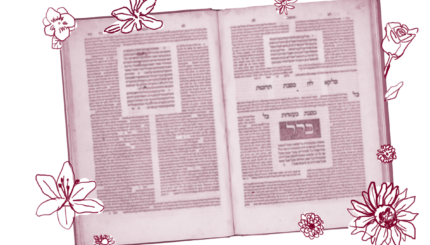When I was in grade school, some young men who fancied themselves fashionable wore their pants loose and low. This allowed the hems of their boxers, complete with prominent branding, to peek out — along with other unmentionable parts of their anatomy. To my amusement, their pants were sometimes worn with belts that did absolutely nothing to raise them to the customary height. In fact, these belts hit, well, let’s just say, below where the buckle is supposed to be.
This is what came to mind for me on today’s daf. The rabbis are discussing a verse from Ezekiel in which the prophet is describing a rebuilt Temple populated with well-dressed priests: “They shall have linen turbans on their heads and linen breeches on their loins; they shall not gird themselves with yaza.” (44:18) In the Talmud, this obscure word requires explanation:
What is the meaning of the phrase in the verse: “They shall not gird themselves with yaza”? Abaye said: They shall not gird themselves in a place in which people sweat (mezi’in). As it is taught in a beraita: When they gird themselves with a belt, they may not gird themselves below their loins nor above their elbows, but rather at the level of their elbows.
Belts, the rabbis assert, have a correct latitude with respect to the human body. Belts at the crotch or the armpits, where one sweats? Absolutely not.
My mother (also a rabbi) always maintained the correct placement for a belt was at the narrow part of the waist. In my youth, I ignored this advice and moved my belt down to my hips, in keeping with the current fashions. (Though I never moved my belt as far south as some of my male counterparts.) I did not then know that according to the Talmud one’s belt should be level with one’s elbows (presumably when the arms are held against one’s sides). This, at least for me, is pretty much at the waistline. Turns out, my mother was right after all.
This belt ruling isn’t just a dress code for priests, but sartorial advice for all Jews:
Rav Ashi says: Huna bar Natan said to me: Once, I was standing before Izgadar, king of Persia, and my belt was raised above its appropriate height, and he lowered it into place and said to me: “A kingdom of priests, and a holy nation,” (Exodus 19:6) is written about you. When I came before Ameimar and recounted this incident, he said to me: With regard to you, God’s promise to Israel: “And kings shall be your foster fathers,” (Isaiah 49:23) was fulfilled.
Huna bar Natan wasn’t just a rabbi, he was the exilarch — the political head of the Jews who represented them to their Persian rulers. When he appeared in court with his belt cinched too high, the king let him know it was disrespectful by tugging it into place. As is common in rabbinic literature, the gentile king then cited the perfect verse to remind him that Israel is a kingdom of priests and a holy nation. In other words, fashion isn’t just for the priests in the Temple; all Israel should place their belts appropriately.
So if you take anything from today’s page of Talmud, remember this: Wear your belt neatly at the waist, just like your mother told you to.
Read all of Zevachim 19 on Sefaria.
This piece originally appeared in a My Jewish Learning Daf Yomi email newsletter sent on October 3, 2025. If you are interested in receiving the newsletter, sign up here.
With your help, My Jewish Learning can provide endless opportunities for learning, connection and discovery.



